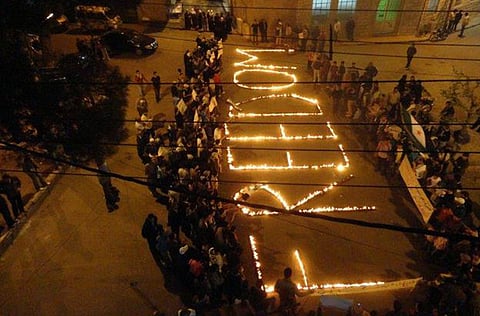Syrian unrest spills into Lebanon for third day
Lebanese gunmen have clashed in street battles as tensions bled across the border for a third day

Tripoli: Firing assault rifles and rocket-propelled grenades, Lebanese gunmen have clashed in street battles as sectarian tensions linked to the 14-month-old uprising in Syria bled across the border for a third day.
At least five people have been killed and 100 wounded in Lebanon's second-largest city since the gunbattles erupted late Saturday, security officials said.
Residents say differences over Syria are at the root of the fighting, which pits neighbour against neighbour and raises fears of broader unrest that could draw in neighbouring countries.
Ties and rivalries
Lebanon and Syria share a complex web of political and sectarian ties and rivalries, which are easily enflamed. Tripoli has seen bouts of sectarian violence in the past, but the fighting has become more frequent as the conflict in Syria worsens.
The fighting camps break down along sectarian and political lines. On one side are Sunni Muslims who support the rebels trying to oust Syrian President Bashar Al Assad.
On the other are members of the tiny Alawite sect, followers of an offshoot of Shiite Islam who are Al Assad's most loyal supporters.
The recent clashes were sparked by the arrest of Lebanese national Shadi Mawlawi, an outspoken critic of Al Assad.
The Sunni fighters say the root of the latest conflict in Tripoli is across the border.
"Syria. It wants it this way. It wants to start a battle here so it can say, look, even in Lebanon the Sunnis are killing the Alawites," said Mustafa Nashar, 35, whose family lives in an apartment overlooking Syria Street, which cuts through the overwhelmingly Sunni Bab Al Tabbani neighborhood.
'Greetings to the free martyrs of Syria'
Posters supporting the Syrian opposition hang on walls, and pictures of a local activist shot by a sniper in similar clashes in February read "Greetings to the free martyrs of Syria" and bear the Syrian revolutionary flag.
On Monday, groups of men, many carrying assault rifles and wearing military-style vests, ducked through trash-strewn alleys.
The residents who remained in the neighbourhood took cues from fighters about when to sprint across alleys to evade the snipers up the hill.
A car with children crouching in the back sped past one alley, a bullet pinging the pavement behind it.
The Lebanese army set up a small position a few hundred metres away from the fighting, but no soldiers or police could be seen in the immediate area.
Mohammad Jaber, a 49-year-old fighter and Tripoli resident, said local fighting has been going on for decades in Tripoli, but the Syria unrest has set it off again.
"The old has become new," he said. "Once the Syrian revolution started, we supported all efforts to get rid of the regime." Sunnis comprise the majority in Syria, but Al Assad and his fellow Alawites play an outsized role in the country's government and security forces, prompting seething resentments.
Inspired by the revolts in Tunisia and Egypt, Syrian protesters defied the authoritarian regime and began taking to the streets in March 2011 to call for political reform.
But a relentless government crackdown led many in the opposition to take up arms. Some soldiers also have switched sides and joined the rebels.
World powers have backed a peace plan for Syria that was put forward by U.N.-Arab League envoy Kofi Annan, but the bloodshed has not stopped.
More than 100 U.N. observers have been deployed in Syria to oversee a truce between the government and armed rebels.
The U.N. estimates the conflict has killed more than 9,000 people.
On Monday, Syrian troops shelled the rebel-held town of Rastan, sparking intense clashes that sent bloodied victims flooding into hospitals and clinics, activists said.
Amateur video
An amateur video posted online Monday showed gunmen apparently taking control of an army position that was being used to shell Rastan.
The video showed a tank, an armored personnel carrier and a military truck in flames.
"The raid liberated the military position," the narrator said. Rami Abdul-Rahman, the head of the Britain-based Syrian Observatory for Human Rights, said 23 soldiers were reportedly killed in the clashes.
He cited rebel fighters but did not identify them, and the account could not be independently confirmed. Rastan, just north of the restive city of Homs, has been under rebel control since January.
The Observatory and the activist Local Coordination Committees said the latest shelling of Rastan started on Sunday.
An amateur video showed a young girl who apparently suffered shrapnel wounds in her thigh undergoing treatment in a makeshift Rastan hospital while screaming in pain.
Shrapnel
Asked where her mother was, the girl cried: "She died!" Another video showed four dead men, half of their bodies covered in a green sheet.
Also Monday, the Observatory and the LCC said government troops stormed the Damascus suburb of Qaboun, where they conducted raids and deployed snipers on roofs of buildings.
In Brussels, the European Union imposed visa bans and asset freezes Monday on three new people associated with the Syrian regime — bringing to 128 the number of Al Assad supporters targeted by the bloc.
Michael Mann, spokesman for EU foreign policy chief Catherine Ashton, said two Syrian entities also were added to the boycott list, which now includes 43 Syrian companies, banks and other organisations.
The new measures, the 15th round of EU sanctions against Al Assad's regime and its supporters, were adopted at a meeting of EU foreign ministers.
The bloc will name the individuals and entities involved on Tuesday, Mann said.
In Damascus, state-run TV said the results of last week's parliamentary elections will be made public Tuesday.
The government has praised the vote as a milestone in promised political reforms, but the opposition boycotted the polls and said they were designed to strengthen Al Assad's grip on power.
Sign up for the Daily Briefing
Get the latest news and updates straight to your inbox



